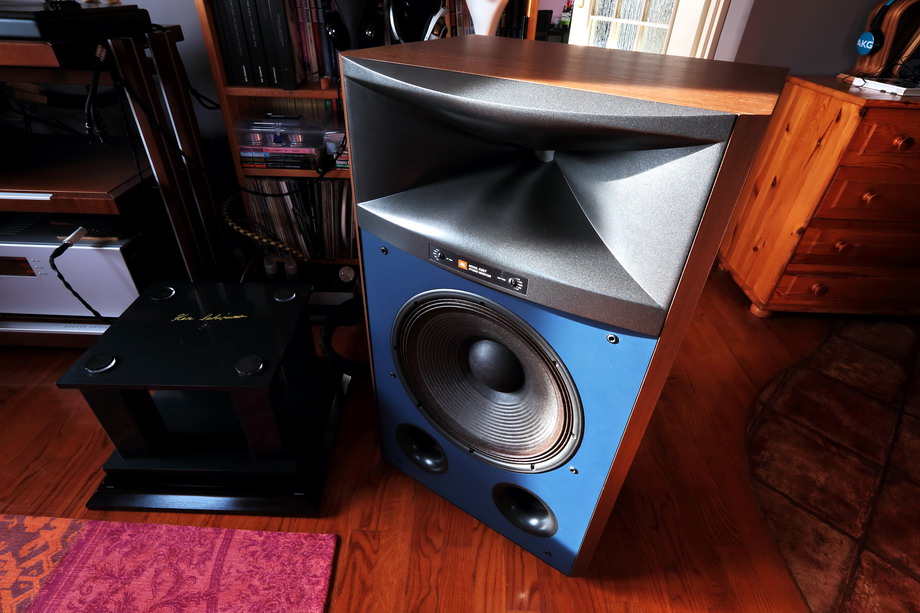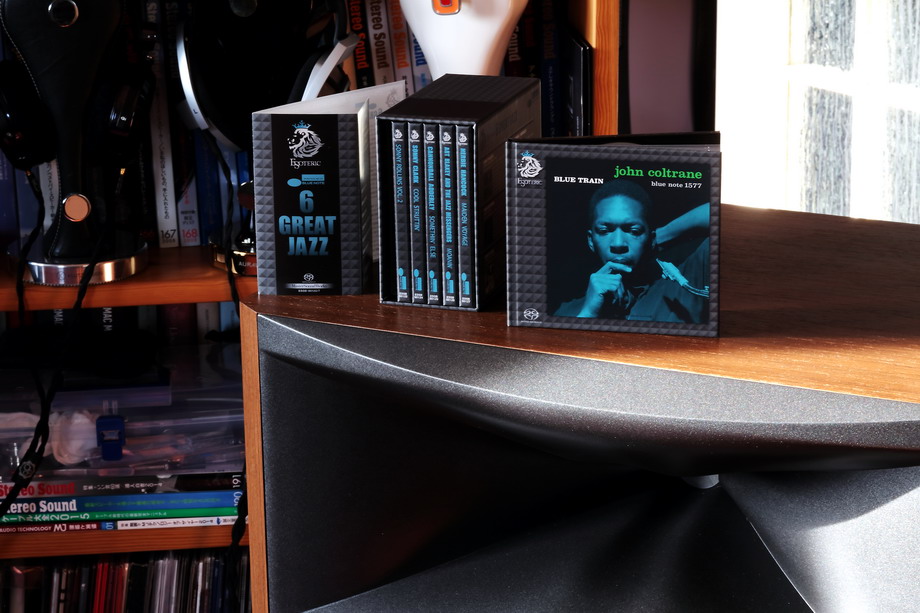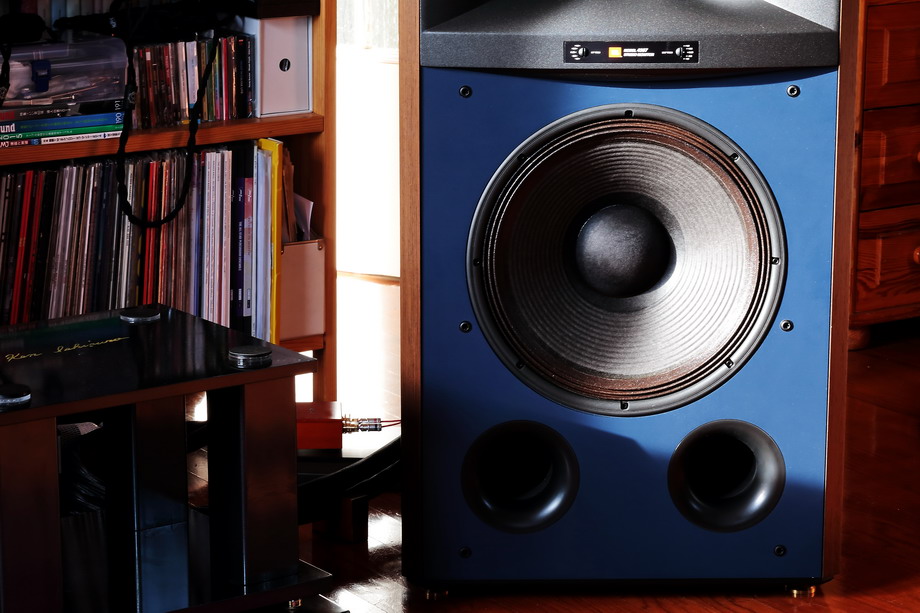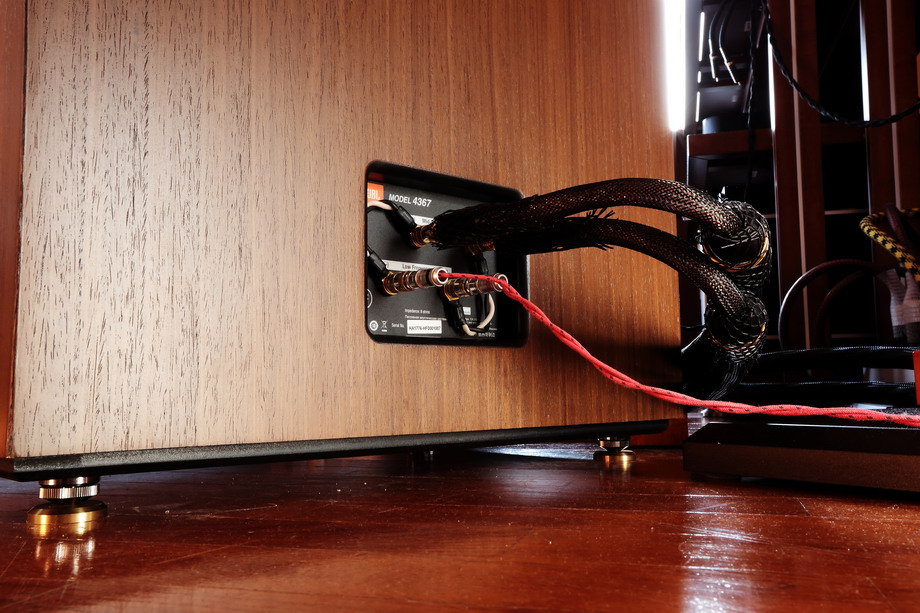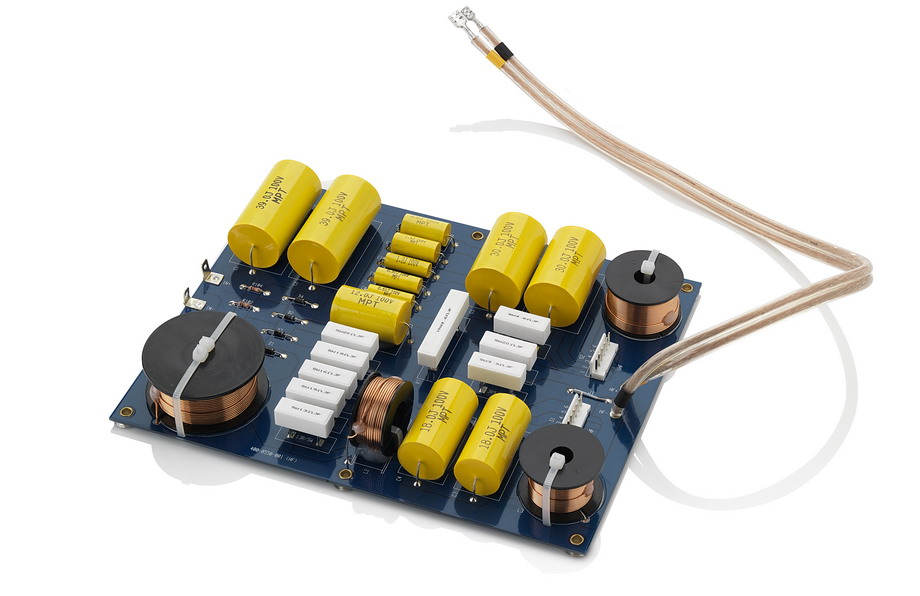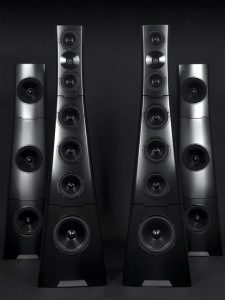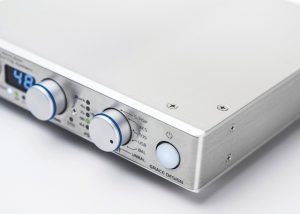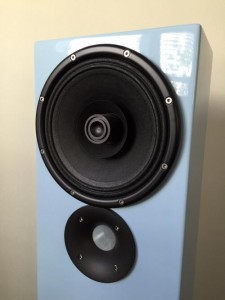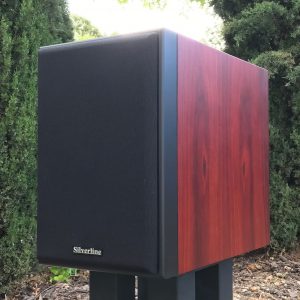The JBL Model 4367 Studio Monitor premiered in October 2015 at CEDIA, and soon after that was also presented during Audio Video Show 2015 in Warsaw. This review is one of the first, if not the first, review of this product in the world.
The goal that was set when designing these speakers was simple: using solutions developed for M2 Master Reference Monitor, which is JBL's reference model of studio monitors, deliver sound of similar quality but at more affordable price. Today that's a top model of Studio Monitor line, replacing Model 4365.
"The JBL M2 has quickly established itself as the new reference standard in professional monitoring environments, and the JBL 4367 brings this high level of sonic accuracy to consumers "—said Jim Garrett, Director of Marketing and Product Management, HARMAN . And added: "With the introduction of the 4367, home listeners everywhere can enjoy listening to music exactly as the artists, producers and engineers intended it to be heard, from a loudspeaker that truly excels in every sonic respect."
source: www.hometoys.com, see HERE
Model 4367 is a two-way speakers with a bass-reflex cabinet. They are huge measuring 941 mm (H) 560 mm (W) and 425 mm (D). They also weight impressive 62 kg (a piece!). They sport steel cone-shape feet that should be placed directly on the floor. The front baffle already says a lot about the design: near the top edge there is a large horn with mid- highrange driver, and below there is a mighty 380 mm woofer with paper membrane sporting neodymium magnet and a double motor system.
Just as Mr Garrett said, JBL with this model introduces a studio monitor to home usage — there are the same drivers (with slight modifications) with passive (and not active) crossover. This loudspeakers in relatively easy to drive with its 6 Ω nominal impedance and 94 dB sensitivity. 4367 sports double speaker posts joined with jumpers.
SETUP
Most of the speakers I review in my room perform best placed in exactly the same spots (measurements refer to the front baffle and the center of the tweeter): 110 cm from the back wall, 240 cm apart and 240 cm from listening spot (I mean me). Same placement worked best for all JBL speakers I reviewed including Model 4367.
I found the best performance in terms of tonal balance and palpability of the sound when tweeters were pointing directly at me — in my room that's a rule for all loudspeakers with wide front baffles. These speakers are really heavy and using spikes so I can't really imaging setting them up with less than 3 people involved.
In my opinion JBL's Monitor line speakers sound best when driven with a high power amplifiers. Japanese disagree and most of them use a low-power SET amps—I admire them for it. It is one of the choices but, in my opinion, it limits the scale of the sound, its dynamics and also a solid soundstage. Although Model 4367 is an easier loading than other JBL models that I reviewed previously. So I guess that a high quality 30W tube amp capable of delivering large current to the speakers should do a great job with 4367. And yet, I would still recommend as much power as you can provide.
SOUND
Recordings used for this test:
- The TBM Sounds!, Lasting Impression Music LIM UHD 048LE, "Limited Edition", CD (2010)
- Anita Lipnicka, Vena Amoris, Mystic Production MYSTCD 244, CD (2013)
- Brian Eno, Another Green World, Island Records/Toshiba-EMI VJCP-68658, CD (1975/2004)
- Depeche Mode, Black Celebration, Mute/Sony Music Labels SICP30539, Blu-spec CD2, (1986/2014)
- Depeche Mode, Ultra, Mute/Sony Music Labels SICP-30543, Blu-spec CD2, (2007/2014)
- Electric Light Orchestra, Out of the Blue, Epic/Sony Music Japan SICP-30111, Blu-spec CD2 (1972/2013)
- Heinrich Ignaz Franz von Biber, Rosary Sonatas, viol. Rachel Podger, Channel Classics CCS SA 37315, 2 x SACD/CD (2015)
- Jim Hall Trio, Blues On The Rocks, Gambit Records 69207, CD (2005)
- John Coltrane, Blue Train, Blue Note/Esoteric ESSB-90123, SACD/CD (1957/2015) w: 6 Great Jazz, "MasterSound Works", Blue Note/Esoteric ESSB-90122/7, 6 x SACD/CD (1957, 1958, 1965/2015)
- Kuniko Kato, Kuniko Plays Reich, Linn Records CKD 385, SACD/CD (2011)
Model 4367 are the biggest JBL speakers I listened to at home. I also know but from different presentation Everest, and K2 models. In fact I listened to them already several years ago when they premiered in Berlin during IFA. There is one thing I can tell you from the bottom of my heart—JBL's decision to continue the great legacy of studio monitors adapted for home usage was a wonderful gift for music fans. We should all thank Japanese who never abandoned the concept of horn speakers with large woofers, because projects like "Monitor" and "Everest" are still alive and well thanks to them.
Another observation I made regarding size of JBL's speakers in relation to the size of the room they are supposed to be used in. Long story short—size of the room doesn't matter. For years (before my own experience with JBL loudspeakers) I couldn't believe what I had seen on many images published in Stereo Sound magazine, showing Readers' systems. I couldn't believe that people put huge, also vintage JBL loudspeakers in rooms of a size of a shoe box. I always thought it was about some sort of fetish for them, but I was wrong! Today I know that even the Everest DD67000 would perform in my room remarkably.
The point is that sound of JBLs is scalable. One uses small (in terms of JBL size) monitors, say, Model 4429, to receive a rich, full, dense sound. One replaces these speakers with, say, S3900 and, apart from some differences in tonality, one gets very similar sound but with larger scale. Finally one replaces them with Model 4367 and everything gets even richer and bigger. But—and that's the clou—bass (in the same room) is not overblown, doesn't get boomy, one never perceives the performance or its elements as exaggerated. With bigger speakers one is simply offered "more" sound, more of everything.
Maybe because the designers managed to create very coherent sounding speakers—one can't hear the drivers separately which is quite an accomplishment considering that it's a horn speakers. It was somewhat easier since it is a two-way speaker and achieving this level of coherence is surely easier when only 2 drivers are used. That is also why these huge loudspeakers sound more coherent than many much smaller 3 or 4 driver designs.
Once you decide to put them in your room you might stop wanting to even leave the room. These JBLs deliver particularly immersive performance and once you "get in" the world of music you don't want to leave it anymore. It is achieved using very rich, dense phantom images presented very closely to the listener. Once I called listening to Everest very similar to headphone experience but without using cans, with powerful, punchy bass I could feel in my guts and with huge soundstage. Listener sits in the middle of spherical soundstage that appears between speakers. You get the feeling that you could touch everything happening around you. You can feel the air filling the room where Kuniko Kato recorded Reich's music, you "sit" among millions of air particles and tape noises when listening to "Kometa" from Aneta Lipnicka Vena Amoris album, and you can almost touch instruments with their surrounding on the phenomenal Blue Note remaster released by Esoteric.
These are the most warm sounding (although not really warm—just warmer than the others) JBL speakers I reviewed, maybe with the exception of Model 4429. It's not about treble roll-off but rather about specific "softness" of midrange, which covers vocals, most of the piano scale and violin. While listening to Rachel Podger playing "Rosary Sonatas" on the new Channel Classic release one can clearly hear a very good differentiation between sound of organ, violin and "air" (our countryman, a teacher of Music Academy in Katowice, Dr Marcin Świątkiewicz plays organ and clavichord). There is a slight emphasis in the upper midrange and treble, hence there is more information in this part of the range than in lower range. Combination of these two features results in sound that is perceived as warm but not dark, without any hint of treble roll-off.
Such a large cabinet, especially as big as this one, creates expectation of an extremely huge bass. But you won't get it. What you get is beautifully balanced with the other part of the range. It is nicely extended but not exaggerated. The much smaller Audiomachina Pure NSE loudspeakers I reviewed recently, with active bass section delivered even better bass extension and better differentiation of lowest notes, which was clear especially with lowest piano and double bass notes. The JBL speakers offered richer, "heavier"/more powerful bass. I was constantly under the impression that there was still some room for even deeper, more powerful sound, like there was no limitation to what these speakers could convey in terms of dynamics, extension and differentiation. Probably that is why this sound is so natural, so relaxing.
Comparing this model to K2, Everest, and to priced at 170 000 PLN Audiomachina Pure NSE, I'd say that lower midrange of Model 4367 is not as resolving as of all the above. The very fast driver in tube works very coherently with large woofer, but exactly at the crossover frequency dynamic differentiation is not that good as it is above and below this point. One should keep in mind that such a large woofer gets quite directional—it is important to take it into consideration when finding optimal spot for loudspeakers in a room.
Summary
The way many top class loudspeakers shape sound might be compared to milling a particular shape from a large block of, say, aluminum. JBL, Harbeth, but also Audiomachina achieve similar final results but using different means—the sound is rather extruded than milled. While milling, layer after layer is taken off while getting the final shape. Extruding means filling in the space that represents instruments. This process delivers more natural sound that one could really feel and not just hear. But at the same time it means that sound is not as resolving.
Model 4367 delivers large scale, unforced sound, wonderful timbre and a huge soundstage. Music is presented closely to listener in a palpable and rather warm way. These are easy to drive speakers but it is no accident that Stereo Sound magazine usually combines JBL Monitors with powerful solid-state amplifiers. I'd say that if any of these speakers could be driven with tube amp it is surely this particular model. These speakers are capable of "scaling" the sound—I mean they will sound equally great in a 20 and 50 sqm rooms. Give them as much space in (any) room as possible and they will repay you with a remarkable performance.
DESIGN
JBL 4367 is a two-way, floor-standing, bass-reflex speaker. It features the company's patented D2 compression driver technology, the D2430k dual-diaphragm, dual-voice-coil compression driver, employs two annular (ring-shaped) diaphragms and two voice coils to deliver extended high frequency response to 40kHz with extremely low distortion even at high volume levels. The annular diaphragms are not subject to the break-up modes of a conventional dome diaphragm, and the use of two voice coils yields a dramatic increase in output and power handling.
The D2 driver operates into JBL's newly developed High-Definition Imaging (HDI) waveguide that provides neutral frequency response both on-axis and off-axis in both the vertical and horizontal planes and a seamless sonic blend with the woofer.
The JBL 4367 features front-panel high-frequency and ultrahigh-frequency trim controls that facilitate optimal sonic adjustment in any system and room. On the back one finds gold-plated, double speakers posts with jumpers.
Crossover is split in two parts—one for treble and midrange and the other for bass. The former sits on a large PCB with 12 polypropylene capacitors, 9 resistors and 4 core-coils. It's hard to call it a minimalistic design but it includes also two trim controls. The bass section of crossover included 2 large air-coils and 4 capacitors. It is mounted on a MDF board using point-to-point technique. All internal connections are made with copper wire without soldering.
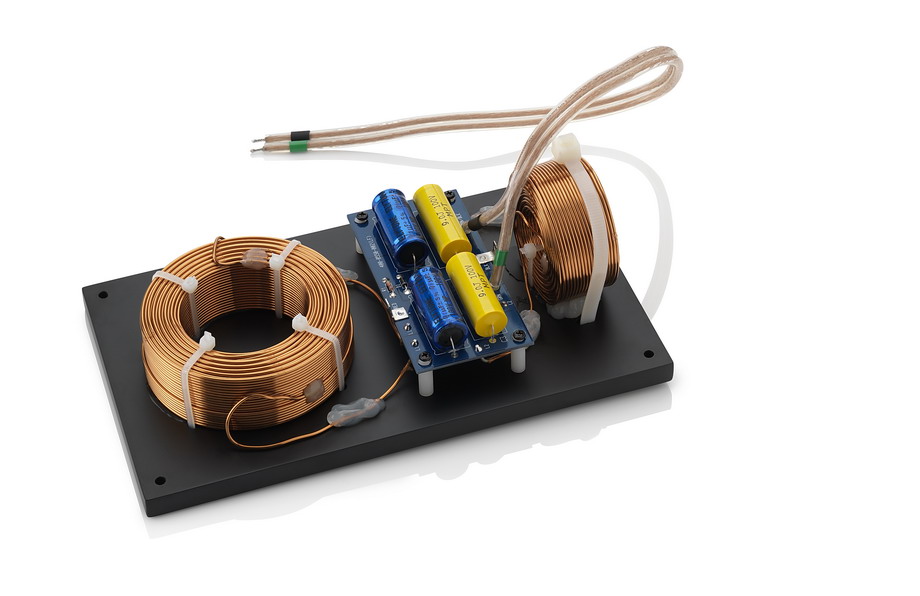
The 4367 employs the JBL 2216Nd 15-inch Differential Drive® woofer used in the M2, modified with a new spider and a new surround treatment. The cast aluminum frame woofer employs a pure pulp cone material, dual 3-inch voice coils and dual neodymium motor structures to provide articulate, authoritative low-frequency performance down to below 30Hz. Just above floor level there are two large bass-reflex ports.
Cabinets are made of thick MDF boards, with internal reinforcements, finished with natural veneer. There are two types of finish available—a natural wood veneer and black lacquer. The front baffle is blue but user had a black grill at his disposal. The grill sports a plastic frame. To be honest I can't image anyone covering these beautiful speakers with a grill—even more so considering that sound differentiation seems better with grill off.
Each cabinet sits on four adjustable steel cones. Speakers are really heavy so its is best if they are moved by at least three people—that's from my experience. I paid for my mistake with an ugly scratch on my wooden floor—luckily (for me) my wife was merciful and forgiving.
Specifications (according to manufacturer)
- Frequency range: 30-40 000 Hz (-6dB)
- Max power: 300 W RMS
- Recommended power amplifier: 25-300 W RMS
- Nominal impedance: 6 Ω
- Sensitivity: 94 dB (2,83 V/1 m)
- Crossover point: 700 Hz
- Dimensions: 941 mm x 560 mm x 425 mm
- Weight: 61,2 kg/PC.
- JBL 4367 Studio Monitor
Price (when reviewed): 15 000 USD/pair
HARMAN International Industries
400 Atlantic Street |15th Floor
Stamford | CT 06901 | USA
MADE IN USA
Text: Wojciech Pacuła
Images: Harman | Wojciech Pacuła




